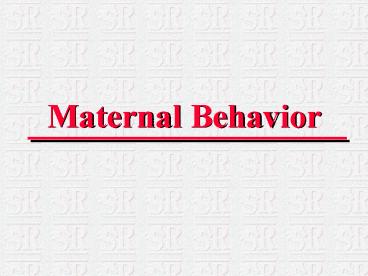Maternal Behavior - PowerPoint PPT Presentation
1 / 21
Title:
Maternal Behavior
Description:
It is used to treat lamb and foal rejection. External Factors that Elicit Maternal Behavior ... dead foal's skin over foster. Cats. will accept fosters ... – PowerPoint PPT presentation
Number of Views:496
Avg rating:3.0/5.0
Title: Maternal Behavior
1
Maternal Behavior
2
Maternal Behavior
- Maternal behavior is influenced by
- Hereditary
- Experiential
- Hormonal
3
Maternal Behavior
- Primiparous females are most likely to neglect or
attack their offspring. - Referring to females having undergone only one
cycle of pregnancy and parturition. - Bond forming with young is dependant upon litter
size.
4
Maternal Behavior
- Internal Factors that Elicit Maternal Behavior
- Hormonal and Neural Controls
- Maternal behavior is characterized by sudden
onset. - Aggression - sudden in onset but does not
persist - Other adult behavior seem to have been rehearsed
by the developing animal in play.
5
Maternal Behavior
- Play includes elements of
- aggression
- sexual behavior
- chasing
- fleeing
- but not of maternal behavior
6
Maternal Behavior
- Maternal behavior is an innate behavior.
- Genetically programmed response to a certain set
of stimuli. - The behaving animal must be physiologically
prepared to respond to the appropriate stimuli.
7
Maternal Behavior
- The stimulation of maternal behavior appears to
be under both hormonal and neural control. - Estrogen rises and progesterone falls at
parturition in sheep - Estrogen appears to facilitate
- Progesterone to inhibit
- maternal behavior in this species.
8
Maternal Behavior
- Learning
- The evidence for the role of learning in maternal
behavior is found mostly in higher primates. - Example Monkeys
- artificially reared monkeys are poor mothers
- Most maternal behavior problems are in
primiparous animals.
9
Maternal Behavior
- Concaveation
- The presence of neonates can induce maternal
behavior in virgin females and even in males. - Mainly studied in rats and mice.
- It is used to treat lamb and foal rejection.
10
Maternal Behavior
- External Factors that Elicit Maternal Behavior
- Olfactory smell of conspecific animal wet with
amniotic fluid. - Auditory newborns calls that may elicit MB
- Visual physical appearance of newborn
- Miscellaneous
- old mare will baby sit
11
Maternal Behavior
- Crossfostering
- transferring offspring from one dam to another
- primarily transferring scent
- litter bears are more willing to accept fosters
12
Maternal Behavior
- Sow
- change piglets at time of parturition or later
- sow cant do anything if in farrowing crate
- smear piglet with sow feces
- Sheep
- critical period for acceptance is shortly after
birth - ewes spend 20-30 min licking lamb
- amniotic fluid smell very important to ewe
13
Maternal Behavior
- Cattle
- amniotic fluid, drape dead calfs skin over
foster - Horses
- nurse mares in industry
- dead foals skin over foster
- Cats
- will accept fosters
14
Maternal Behavior
- Nursing
- newborn will seek udder/teat
- nuzzle along looking for teat
- nursing activity increases as milk is letdown
- general stages to milk letdown
- massage udder
- quiet period while waiting
- true suckling for a varied period of time
15
Maternal Behavior
- Recognition
- Swine use vocal and olfaction
- Sheep use visual, olfaction, audition
- recognition cues reinforced at every nursing
- have to impair 2 of the 3 senses before she cant
find lamb - audition important for lamb early in life
- visual more important later
- tendency to follow is highest during 1st 3 days
of life
16
Maternal Behavior
- Cattle
- bonds w/ calf in 1st 5h postpartum
- Horses
- audition, vision, olfaction
- orient to sound, confirm w/ vision
- Cats
- smell, sound for retrieval
- Dogs
- pups use voice and smell
- bitch hears the pup notices it was gone when she
sees it
17
Maternal Behavior
- Rejection/Problems
- swine will cannibalize
- esp. nervous primiparous gilts
- mastitis - sore udder - attack piglets
- sheep
- lamb could roll away from birth site, wont have
amniotic smell - leads to neglect
- may steal a lamb before she has own lamb,
- end up with twins
- mismothering increases w/ confinement at
parturition
18
Maternal Behavior
- Cattle
- smell can reject or not nurse
- Horses
- rejection or fear of suckling
- sore udder
- mare is Ok being around but wont tolerate
suckling - restrain, tranquilize, hand milk
19
Maternal Behavior
- Fear of foal
- mare tries to escape
- kick at foal
- try to stimulate maternal defensiveness
- introduce 2nd horse
- attack foal
- will bite withers, throw, kick foal
- hasnt licked membranes off foal
- can use punishment, passive restraint, nurse mare
20
Maternal Behavior
- Cats
- toms may kill kittens
- routine in lion prides
- cannibalism possible but rare
- Dogs
- rejection can occur esp. if C-section performed
- anesthetized when normally would be licking and
smelling - attack after parturition is rare
21
Maternal Behavior
- Defense of young
- sow can be extremely dangerous bark
- basically, all dams, esp. w/ newborns, should be
approached cautiously - let dam get used to people around her young/litter































